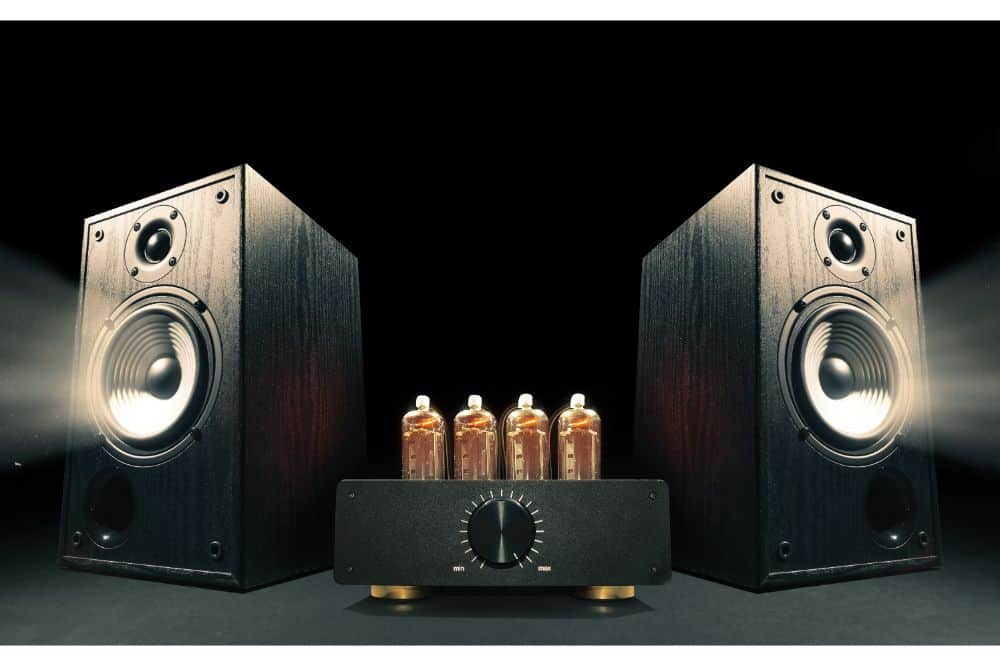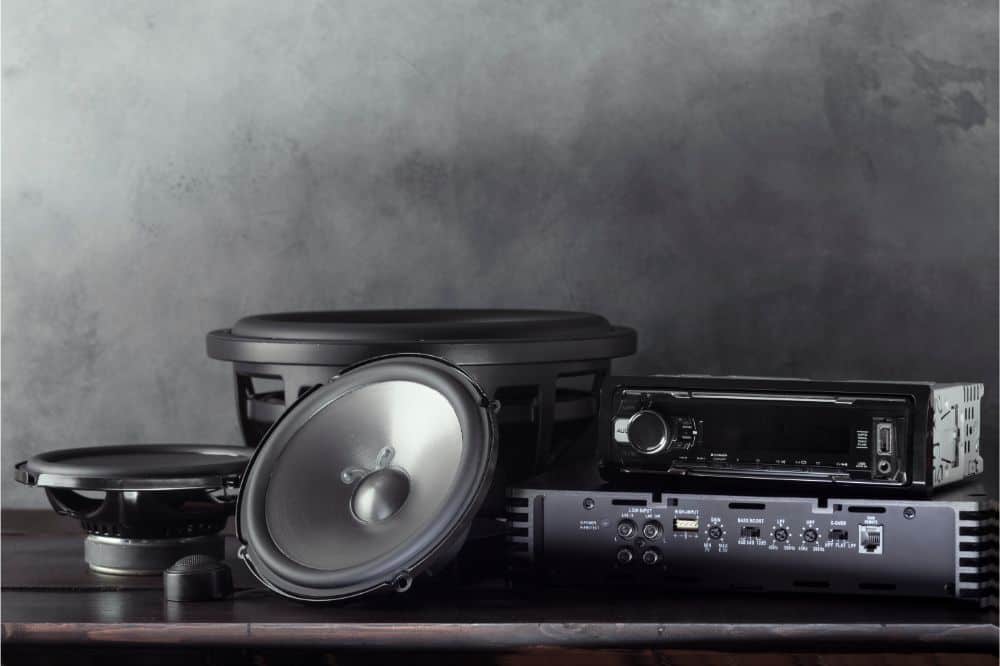As far as PA equipment goes, especially for beginners, it can be a never-ending struggle of trying to figure out which goes where and how.
For example, you could be asking, “Can you use an amp with powered speakers?”
We know you’re excited to hook those brand-new speakers to your existing rig, but not so fast! You want to make sure you do things safely and correctly.
Only start hooking those audio connections or cables up after you’ve read and understood this quick guide.
- Can You Use an Amp With Powered Speakers?
- What Are Powered Speakers?
- Powered Speaker Technology
- Using Active Loudspeakers at Home
- Passive Crossover Speakers vs. Powered Speakers
- What Is A Power Amplifier?
- Power Amplifier + Active Speaker = A Disastrous Combination
- The Solution to Your Problem
- Connecting Hi-Fi Equipment
Can You Use an Amp With Powered Speakers?
Seeing as we do not want you to do anything you will regret, we’ll get to the answer right now.
No, you absolutely must not connect your amp to a powered speaker.
You would be able to do it physically, but there is a high likelihood that you’ll ruin both the amp and the powered speaker when you do.
When you connect power to power, as in the case of power amplifiers and powered speakers, you could potentially blow up your speakers and destroy the amp.
So, instead, what you should do is read on as we explain how to hook those cables up correctly and bring out the best sounds in those killer speakers.
What Are Powered Speakers?
Powered speakers, which are also sometimes categorized as active speakers, are loudspeakers with built-in amplifiers.
In other words, that means that a pair of these speakers do not need a separate amplifier to reproduce sound.
Their built-in amplifier gives them both the power and sound quality you need in your home theater system.
Speaker manufacturers started to go down this road of designing speakers in the ‘80s for home theater components and audio components.
The development was only later introduced to the larger types of speakers, specifically around the 2000s.
These days, you can choose from compact speakers, bookshelf style speakers, 2-way active speakers, low-cost powered speakers, and so much more.
You’re literally spoilt for choice where powered speaker systems are concerned in both design and technology.
Powered Speaker Technology
There are different kinds of speakers, each with its own active speaker models. Let’s go over them briefly below.
PA Systems
In the world of commercial speakers, PA systems have seen the most progress in terms of size and design options, as well as sound quality.
From an 8” stand-alone speaker, sub-low 18-inch speakers, and theater speakers to the ultra-powerful 18-inch, 3000-watt subwoofer, the options are practically limitless.
You should find an 8-inch active speaker most suitable for everyday use.
On the other hand, the self-powered (active) floor monitor is the way to go if you want to become an artist.
Studio Monitors
Studio monitors are available in a wide range of frequencies and configurations.
If you’ve ever seen music production done in a large studio, you’d have witnessed monitors of different sizes in action.
Low frequencies would have had bigger monitors spaced farther apart and away from the artist.
In contrast, mid and high frequencies would have had smaller ones positioned closer together and near the artist.
These would mostly be active speakers to ensure virtually 100 percent flat audio.
Powered amplifiers used to be placed beneath the mixer console to add noise to audio signals, but that is no longer the case today because of active speakers.
Line Array PA Systems
If you’ve been to your fair share of festivals, chances are you’d have set eyes on line array PA systems in the area.
Though smaller than the traditional PA system, they are more powerful.
Their speaker components usually hang on either side of the stage and produce equal or more power than traditional speakers four times their size.
Additionally, these systems are made up of mostly active loudspeakers.

Using Active Loudspeakers at Home
Home theater systems with active speakers and Bluetooth technology eliminate the hassle of having cables all over the place.
In addition, self-powered (active) speaker towers are the ideal companion for date pre-amplifiers.
You can also use them to stream content straight from your computer or mobile device.
Lastly, a good number of active speakers also come with a built-in karaoke feature, rechargeable batteries, and cool lighting.
Passive Crossover Speakers vs. Powered Speakers
You will encounter “crossover” a lot as you learn more about PA systems.
It is the “fork” that divides audio signals, ensuring that high-frequency signals go to the tweeter and the low ones go to the woofer.
The biggest difference between crossovers for these two speaker types is that power is not needed for passive speakers.
In these devices, inductors and capacitors are used to direct the signal as they reach a specific figure or value.
Active crossovers, on the other hand, identify and direct signals before they reach the power amplifier and create a cleaner, crisper sound as a result.
Passive ones are the more budget-friendly options, while active ones provide the pricier alternatives. So, take that into consideration before you buy.
What Is A Power Amplifier?
Are you wondering what a power amplifier does? Well, you might not have to wonder any longer after reading this.
Practically and intuitively speaking, we sort of know what power amps do. However, none of us are really quite sure what goes on inside the device.
So, what the power amp does is that it receives sound signals and amplifies them by adding more current. This way, speakers can play them at an optimal volume for audiences.
These amps can be either standalone pieces or built-in parts of power mixers.
Power Amplifier + Active Speaker = A Disastrous Combination
So, can you use an amp with powered speakers?
In your quest to answer this question, you may find yourself treading the fine line between loud, clean sounds and blown-up speakers.
Mixing power with power, especially where these pieces of equipment are concerned, is bound to result in disastrous consequences.
We aren’t just talking about both devices blowing up potentially; we’re talking about them blowing up while you’re there!
Always remember this golden rule when connecting sound system components: a powered amplifier should never be plugged into a powered speaker.
That’s because the powered output’s excess current can combine with the input’s current and overpower the entire system.
What happens next is that you risk the two devices blowing up.
The Solution to Your Problem
Don’t lose hope just yet, as there are ways to connect active speakers and power amps without destroying your home theater system.
Here is a scenario where you might be able to do just that:
Mixer Has Another Output
If there’s more than a single output in your current active mixer, then thank the heavens! You may be able to connect your amp to your active speaker.
Check the manual to determine if the device has any balanced (not amplified) outputs.
State-of-the-art consoles usually have un-amplified line outs for connecting to active speakers.
In these types of equipment, you can use an active subwoofer to amp low frequencies and a power mixer to do the same to mid-range frequencies.
That said, some mixers will come with both amplified outputs and un-amplified line outs for monitoring.
Connecting Hi-Fi Equipment
Active speakers have become the answer to many of our sound problems over the years. You cannot deny how they’ve changed the sound industry for the better.
Despite that, it is still vital to learn and understand more about them before using a system with mostly active speaker components.
You could connect a power amp to your power speakers while failing to consider if the scenario would allow for it to be done safely and correctly.
That may result in blown-up speakers and an unscheduled studio renovation. And that’s now even the worst of it!
Luckily, you’ve happened upon a post that can save you from the consequences of careless and incorrect connections between audio and theater components.
Once you determine that the circumstance does not allow you to connect your power amp to your active speaker safely and correctly, don’t push it.
Power plus power, when you don’t have the appropriate line outs to make a safe connection, can result in disastrous consequences.

